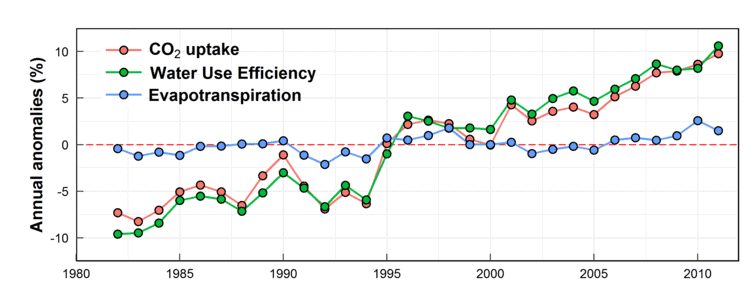Australian researchers from CSIRO found land-based plants are absorbing 17% more CO2 than they did 30 years ago. That was somewhat expected, though you could argue on the figure itself, seeing how the rate of CO2 emissions has risen over this timeframe. What’s particularly remarkable about the authors’ report, though, is that all this vegetation seems to hardly use any extra water. It follows that plants are now using water more efficiently to store CO2, one of the few good things to come out of anthropogenic climate change.

The ratio of carbon uptake to water loss is called “water use efficiency”, and it’s one of the most important variables scientists follow when studying ecosystems.
Today’s CO2-rich atmosphere is making plants take up more carbon in what’s called the CO2 fertilization effect. This carbon uptake trend is confirmed by a global green trend which is plainly observed by satellites but also by sediment samples that show the global land carbon sink is growing.
Managing extra CO2 isn’t easy for plants, though. To let CO2 in, plants open up the stomata found in the leaves. These pores let the CO2 in but also the water out so plants need to find a balance between building more biomass and minimizing water loss. Some of the adaptations plants evolved over the years are so sophisticated that some species can survive even in the aridest environments in the world. One such adaptation involves slightly closing the stomata to have less water seeping out. At the same time, since the CO2 concentration in the atmosphere is currently about 0.04 percent or 400 parts per million by volume (ppm) — higher than it has been at any time in the past 400,000 years — the net effect is more CO2 uptake while water consumption stays the same.
The Australian researchers designed a new efficiency model which took into account water flux and atmospheric measurements, but also satellite observations of plant growth.
Using this model, the team found that boreal and tropical forests were particularly good at increasing water use efficiency and CO2 update. The authors report that this is likely due to the leaf surface area which is larger than in other parts of the world. Moreover, tropical forests absorb more CO2 than any other type of forest in the world while boreal forests hold the most amount of carbon in their organic soils.
As for arid environments, the Australian ecosystems, for instance, have increased their carbon uptake too. This wouldn’t have been possible without an increase in ecosystem water use efficiency as well. It’s quite possible that if this trend continues, we could witness a greening of semi-arid regions which in turn would improve the carbon sink potential, as suggest previously.
The findings published in Nature suggest that plants all around the world will benefit from the increased water savings but this doesn’t necessarily mean that there will be more water availability for human consumption or conservations. Even so, It’s nice to hear about some positive effects of climate change for a change even though the net effect actually puts millions of species that live on Earth at risk.


